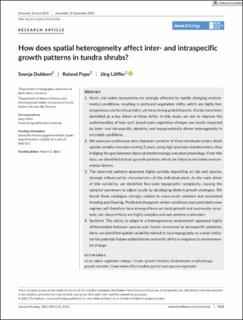| dc.contributor.author | Dobbert, Svenja | |
| dc.contributor.author | Pape, Roland | |
| dc.contributor.author | Löffler, Jörg | |
| dc.date.accessioned | 2022-03-07T11:08:11Z | |
| dc.date.available | 2022-03-07T11:08:11Z | |
| dc.date.created | 2021-11-02T22:47:29Z | |
| dc.date.issued | 2021 | |
| dc.identifier.citation | Dobbert, S., Pape, R. & Löffler, J. (2021). How does spatial heterogeneity affect inter- and intraspecific growth patterns in tundra shrubs? Journal of Ecology, 109(12), 4115-4131. | en_US |
| dc.identifier.issn | 0022-0477 | |
| dc.identifier.uri | https://hdl.handle.net/11250/2983375 | |
| dc.description.abstract | 1. Arctic and alpine ecosystems are strongly affected by rapidly changing environmental conditions, resulting in profound vegetation shifts, which are highly heterogeneous and hard to predict, yet have strong global impacts. Shrubs have been identified as a key driver of these shifts. In this study, we aim to improve the understanding of how such broad-scale vegetation changes are locally impacted by inter- and intraspecific plasticity and topographically driven heterogeneity in microsite conditions.
2. We assessed continuous stem diameter variation of three dominant tundra shrub species at daily resolution during 5 years, using high-precision dendrometers, thus bridging the gap between classical dendroecology and plant physiology. From this data, we identified distinct growth patterns which we linked to microsite environmental drivers.
3. The observed patterns appeared highly variable depending on site and species, strongly influenced by characteristics of the individual plant. As the main driver of this variability, we identified fine-scale topographic complexity, causing the sampled specimens to adjust locally by developing distinct growth strategies. We found these strategies strongly related to snow-cover variation and associated freezing and thawing. Predicted changes in winter conditions and associated snow regimes will therefore have strong effects on shrub growth and community structure, yet, these effects are highly complex and not uniform in direction.
4. Synthesis. The ability to adapt in a heterogeneous environment appeared highly differentiated between species and closely connected to intraspecific plasticity. Here, we identified spatial variability related to local topography as a main indicator for potential future redistribution and niche shifts in response to environmental change. | en_US |
| dc.language.iso | eng | en_US |
| dc.rights | Navngivelse-Ikkekommersiell 4.0 Internasjonal | * |
| dc.rights.uri | http://creativecommons.org/licenses/by-nc/4.0/deed.no | * |
| dc.title | How does spatial heterogeneity affect inter- and intraspecific growth patterns in tundra shrubs? | en_US |
| dc.type | Peer reviewed | en_US |
| dc.type | Journal article | en_US |
| dc.description.version | publishedVersion | en_US |
| dc.rights.holder | © 2021 The Authors. | en_US |
| dc.source.pagenumber | 4115-4131 | en_US |
| dc.source.volume | 109 | en_US |
| dc.source.journal | Journal of Ecology | en_US |
| dc.source.issue | 12 | en_US |
| dc.identifier.doi | https://doi.org/10.1111/1365-2745.13784 | |
| dc.identifier.cristin | 1950800 | |
| cristin.ispublished | true | |
| cristin.fulltext | original | |
| cristin.qualitycode | 2 | |

